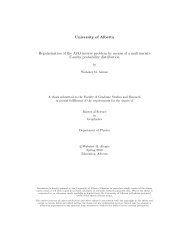Soner Bekleric Title of Thesis: Nonlinear Prediction via Volterra Ser
Soner Bekleric Title of Thesis: Nonlinear Prediction via Volterra Ser
Soner Bekleric Title of Thesis: Nonlinear Prediction via Volterra Ser
Create successful ePaper yourself
Turn your PDF publications into a flip-book with our unique Google optimized e-Paper software.
3.3. 1-D SYNTHETIC AND REAL DATA EXAMPLES 42<br />
Samples<br />
−4 −2 0 2<br />
0<br />
50<br />
100<br />
(a)<br />
Amplitude<br />
Samples<br />
Samples<br />
−4 −2 0 2<br />
0<br />
50<br />
100<br />
(b) (c)<br />
Amplitude<br />
−4 −2 0 2<br />
0<br />
50<br />
100<br />
(d) (e)<br />
Amplitude<br />
Samples<br />
Samples<br />
−4 −2 0 2<br />
0<br />
50<br />
100<br />
Amplitude<br />
−4 −2 0 2<br />
0<br />
50<br />
100<br />
(e) (f)<br />
Amplitude<br />
Figure 3.4: 1-D synthetic data for comparison <strong>of</strong> prediction between linear prediction<br />
theory and third order <strong>Volterra</strong> series. (a) Original data. (b) <strong>Prediction</strong> using<br />
a third-order <strong>Volterra</strong> series (p = 8, q = 8, and r = 8). (c) The error between the<br />
original data and the third-order <strong>Volterra</strong> prediction. (d) <strong>Prediction</strong> using the first<br />
order <strong>Volterra</strong> series, which is equivalent to linear prediction (p = 8). (e) The error<br />
between the original data and linear prediction.<br />
to the linear kernel (p = 10). Figures 3.7(d) and 3.7(e) show the parts <strong>of</strong> the<br />
prediction associated with quadratic (q = 10) and cubic (r = 10) terms in the<br />
third-order <strong>Volterra</strong> series. In addition, Figure 3.7(f) illustrates the part <strong>of</strong> the









